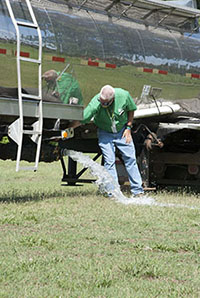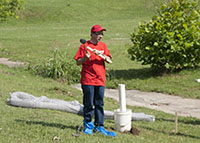Manure is a valuable commodity that provides needed nutrients for crop acres, but it takes multiple steps to get it from Point A to Point B. Most times, moving manure from storage to the field happens with few problems. However, occasionally a mechanical or equipment failure, an accident or negligence occur and cause a spill.
"It's not illegal to have an accidental spill," said Kevin Erb, University of Wisconsin-Extension conservation professional development and training coordinator. "Failure to report it is when you'll have problems."
A spill is any manure release that has the potential to threaten ground or surface water, or any spill that has the potential to create a hazardous situation. The amount of manure that quantifies the seriousness of a spill is site specific. For example, 3,000 gallons applied on an acre of cropland is not the same as 3,000 gallons applied a few feet from a stream or spilled in a road ditch.
To help teach livestock producers, first responders and government officials alike how to contain spilled manure, Erb has conducted more than 20 real-life demonstrations in Wisconsin and beyond. The most recent manure spill response demonstration was held during the North American Manure Expo in Springfield, Mo. earlier this month.
"Being prepared is critical," Erb said to the conference attendees. "It's best to follow the law and contain the spill."
Not being prepared in the event of a manure spill can cost critical time. Erb recommends having a plan in place, including the following steps:
"It's not illegal to have an accidental spill," said Kevin Erb, University of Wisconsin-Extension conservation professional development and training coordinator. "Failure to report it is when you'll have problems."
A spill is any manure release that has the potential to threaten ground or surface water, or any spill that has the potential to create a hazardous situation. The amount of manure that quantifies the seriousness of a spill is site specific. For example, 3,000 gallons applied on an acre of cropland is not the same as 3,000 gallons applied a few feet from a stream or spilled in a road ditch.
To help teach livestock producers, first responders and government officials alike how to contain spilled manure, Erb has conducted more than 20 real-life demonstrations in Wisconsin and beyond. The most recent manure spill response demonstration was held during the North American Manure Expo in Springfield, Mo. earlier this month.
"Being prepared is critical," Erb said to the conference attendees. "It's best to follow the law and contain the spill."
Not being prepared in the event of a manure spill can cost critical time. Erb recommends having a plan in place, including the following steps:
- Assure human safety. Call 911 immediately for all road incidents.
- Stop the flow at the source. This is very important if flow is from a manure storage structure.
- Contain and control existing spill. Keep manure from entering waterways, ditches and wells. Hay bales, plywood and a chisel plow are all useful for creating dams and stopping the flow.
- Notify the proper authorities. Reporting a manure spill is mandatory in most states; check yours for specific requirements. In Wisconsin, for example, all spills must be reported to the DNR.
- Clean up the spill. Know who you can contact to locate the equipment, such as a vacuum truck or a backhoe, needed to collect spilled manure and apply it to cropland. Use water to flush manure solids out of ditches and waterways. You should work to restore the site to its original form.



Kevin Erb, UW-Extension, conducts manure spill response demonstrations to teach producers, first responders and government officials how to properly deal with a manure spill. Typically, Erb's demonstrations use real manure, but since this one took place at the Ozark Fairgrounds, water was used instead to simulate the flow and show observers containment techniques.

The author is an associate editor and covers animal health, dairy housing and equipment, and nutrient management. She grew up on a dairy farm near Plymouth, Wis., and previously served as a University of Wisconsin agricultural extension agent. She received a master's degree from North Carolina State University and a bachelor's from University of Wisconsin-Madison.









